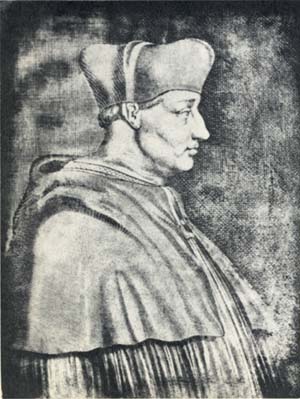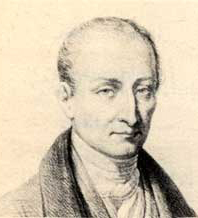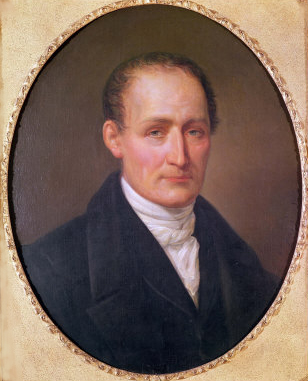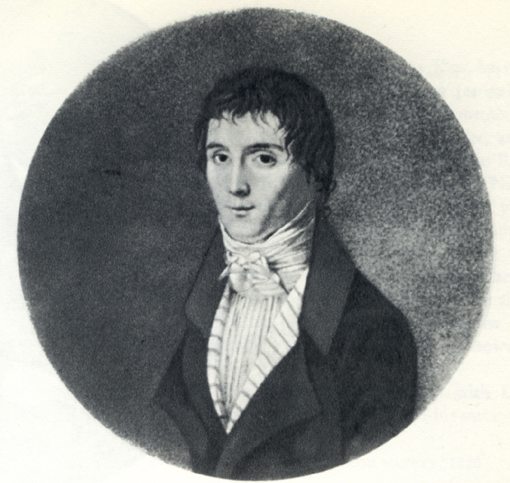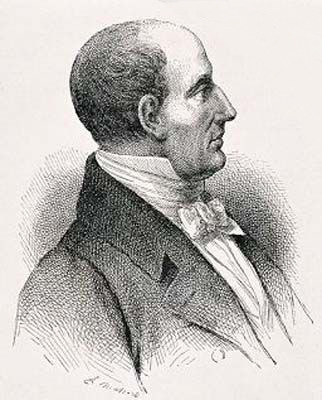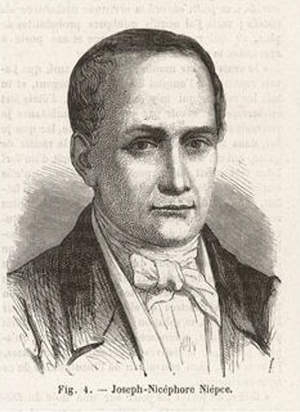 [ABOVE] An idealised posthumous portrait of Joseph Nicéphore Niépce (1765-1833), painted by the artist Léonard-François Berger in 1854, some 20 years after the inventor's death. |
Joseph Nicéphore
Niépce
(1765-1833) Joseph Niépce was born on 7th March 1765 in Chalon-sur-Saône, France, the son of a wealthy landowner who had served as a King's Counsellor and a Royal Tax Collector. At school, Joseph developed a strong interest in physics and chemistry and in adult life he became an amateur scientist and inventor. In his early twenties, Niépce dropped his biblical Christian name of Joseph and adopted Nicéphore as a first name. ( The name Nicéphore was derived from the Greek words nike phoreo meaning "Victory Bearer" ). After serving as an officer in the French Revolutionary Army, Nicéphore Niépce returned home in 1801 to manage the family estate at Chalon-sur-Saône with his elder brother Claude. Since the mid 1790s, Nicéphore and Claude Niépce had been working together, conducting scientific experiments and inventing various machines, including a type of internal combustion engine, which the two brothers eventually patented in 1807. During a visit to Sardinia in 1797, Nicéphore Niépce and his brother Claude discussed the idea of capturing images of nature through the agency of light. Around 1816, on his estate in Chalon-sur-Saône, Nicéphore Niépce began his first serious experiments in photochemistry. Using a specially made camera, Niépce managed to produce an image on sensitized paper, but he was unsuccessful in permanently fixing the resulting negative. After attempts to make positive pictures by contact printing from the negatives, Niépce abandoned the idea of using negatives and concentrated instead on creating positive images inside a camera. In the early 1820s, because of his interest in lithography (printing from images fixed on stone), Nicéphore Niépce began experimenting with a resinous substance called "bitumen of Judea", a kind of asphalt. For Niépce, bitumen of Judea had particular properties which would prove useful in the production of positive images - bitumen of Judea hardened when exposed to light and as it hardened the bitumen turned pale grey. Niépce also discovered that any of the bitumen material which was unexposed could be dissolved in lavender oil and then washed away. In his early experiments with bitumen of Judea, Niépce used the light sensitive properties of the substance to reproduce line drawings and engravings. He would dissolve the bitumen of Judea in lavender oil and then coat a glass plate with the mixture. A line drawing or engraving on paper would be made translucent with oil and then placed face down on the specially coated glass. The picture on the glass plate was then exposed to strong sunlight. Where the light shone through the blank areas of the picture, the bitumen hardened. The dark lines of the drawing or engraving shielded the areas of the sensitized plate below and the mixture in these parts remained soft. The soft, soluble areas of the coating could be then washed away with lavender oil, leaving a positive image behind. Niépce realised that by basically using the same process, he could produce a positive image inside a camera. |
